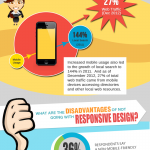
Many business owners today tend to ignore the importance of having a mobile friendly or “responsive” website. Without realizing it, they may be losing prospective leads and sales because their website is not designed to load properly on mobile devices such as laptops, tablets, and smartphones. Here’s why you should not be one of them, and how you can make your website responsive: Watch the video: What is Mobile Responsive Web Design? Your website needs to be mobile friendly, so it needs to be “mobile responsive.” Responsive design is when your website automatically responds or adjusts on the fly to the screen size of the device viewing it. In effect, be it a desktop, a laptop, tablet, or smartphone, your website will load properly. Users Favor Mobile Friendly Sites According to a study commissioned by Google, 74% of users are more likely to return to a mobile-friendly site. But that’s not all. Some 67% of users are more likely to buy if the site is mobile friendly. On the other hand, if your website is not friendly to mobile viewers, you could be in trouble. On the same study, it was found that 48% of users are “frustrated” and “annoyed” by a non-mobile-friendly website. Some 48% said a company “doesn’t care” about its business if its site is not mobile friendly. Some 52% of users are unlikely to engage with a business that has a non-mobile-friendly site. More Mobile Devices Connected Online You need a responsive site as more and more people are using mobile devices to browse online. First of all, ABI Research estimates that there will be 1.4 billion smartphones by the end of 2013. With the current population at 7 billion, that’s 1 smartphone for every 5 people. Meanwhile, comScore estimates that 28% of smartphone owners also […] Read more »
